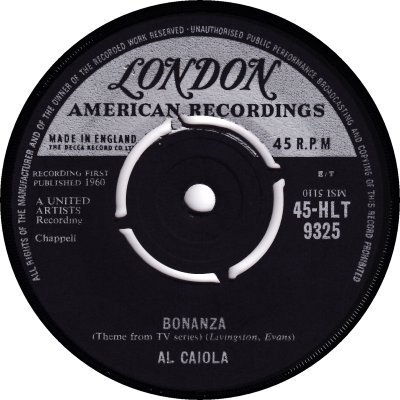
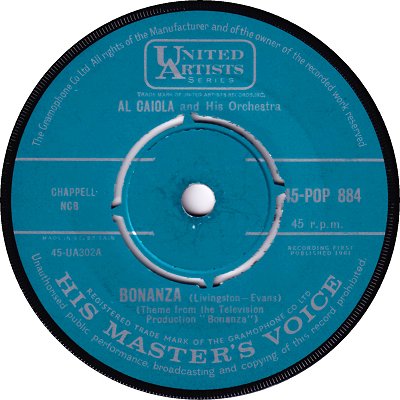
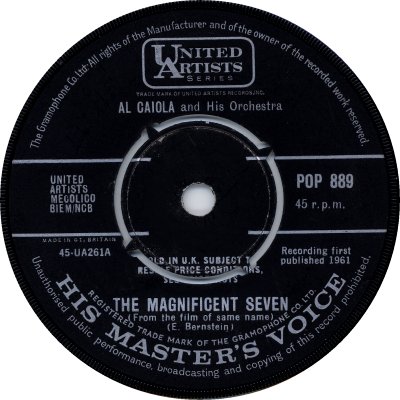
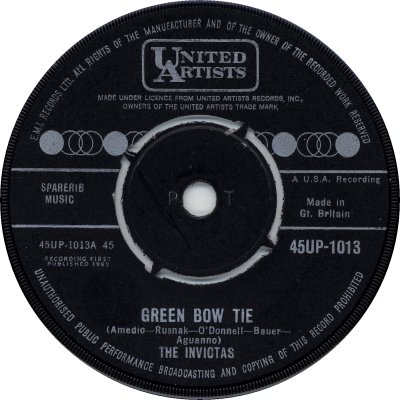
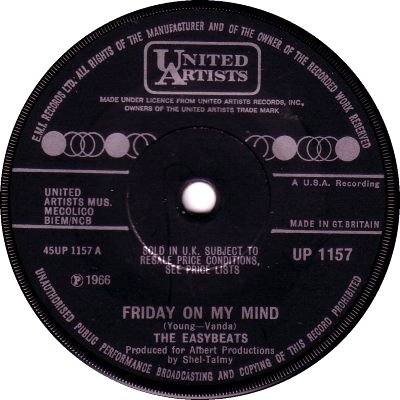
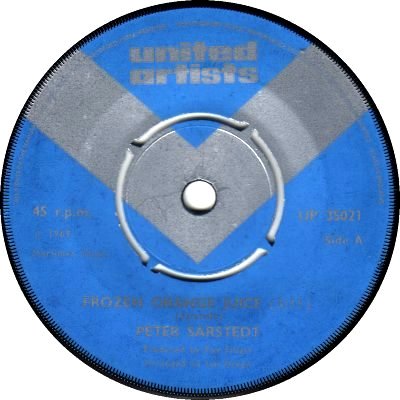

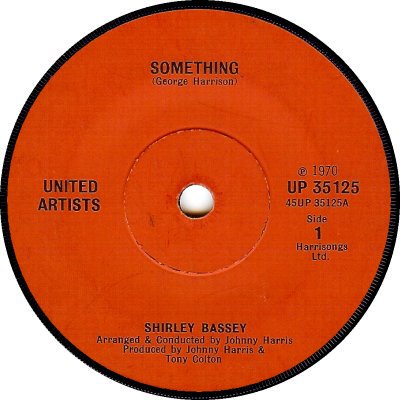
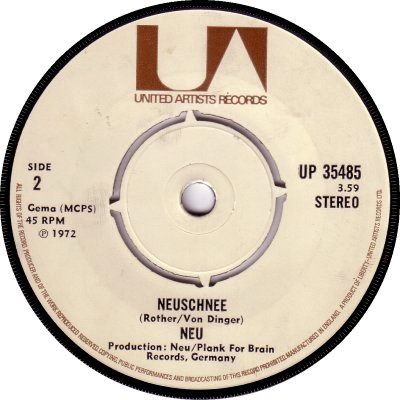
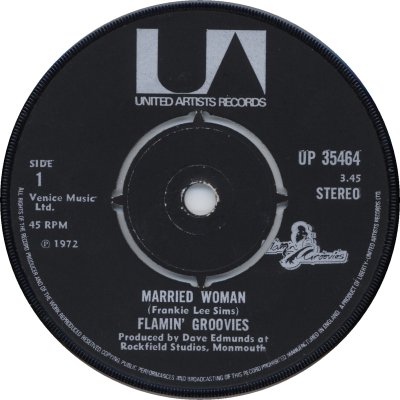
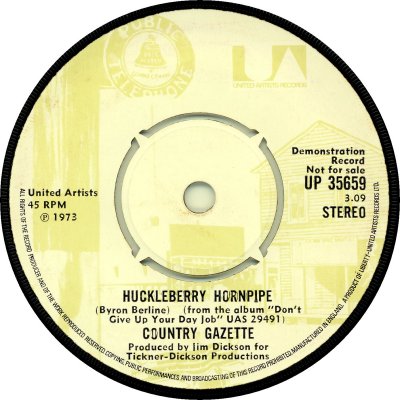
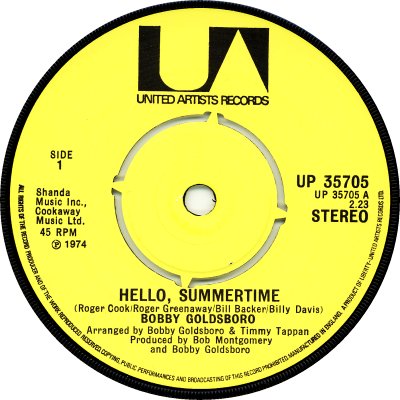

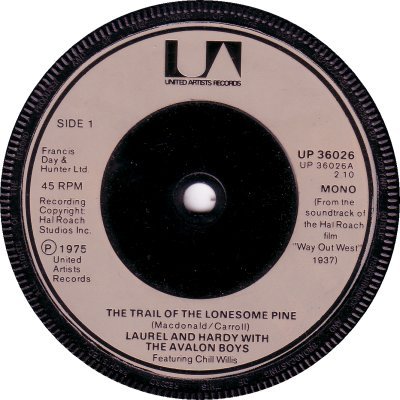
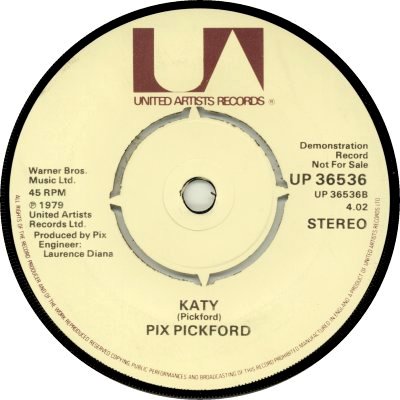
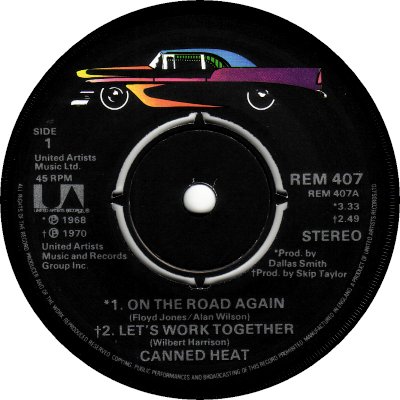
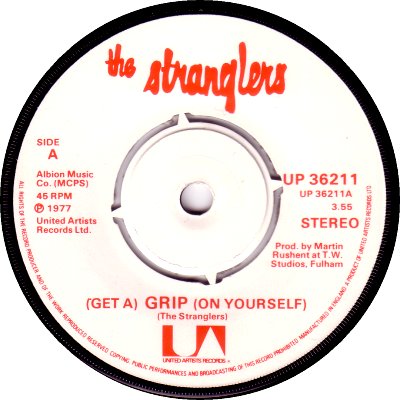


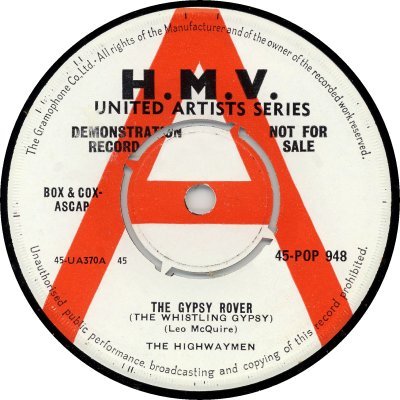
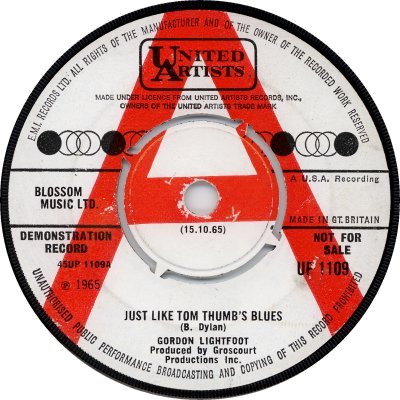
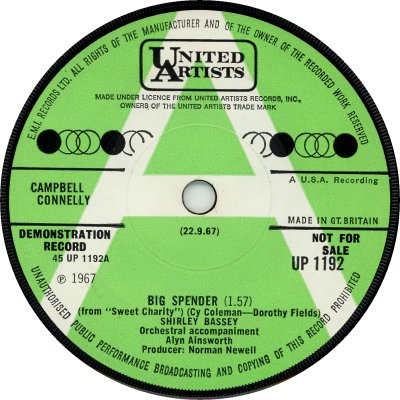
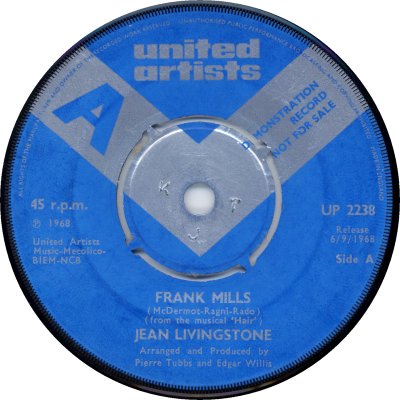
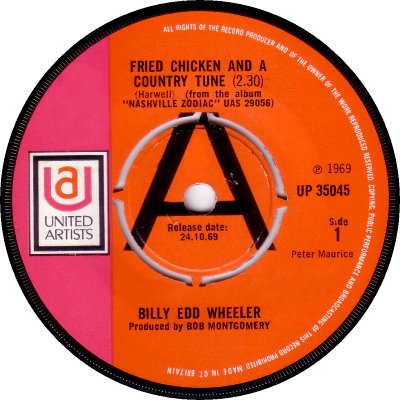
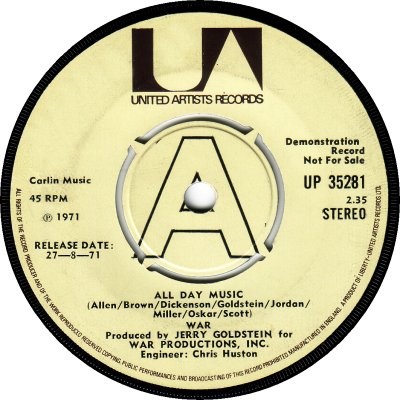
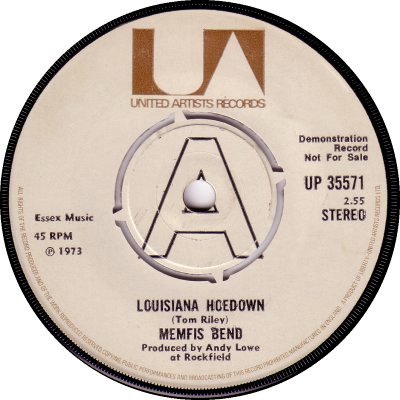
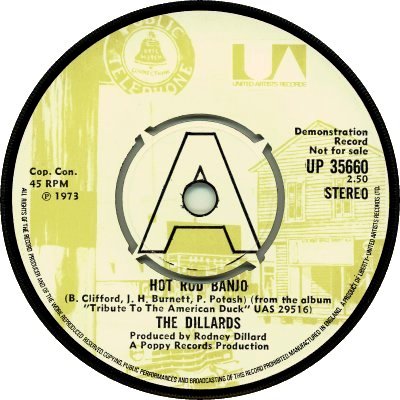
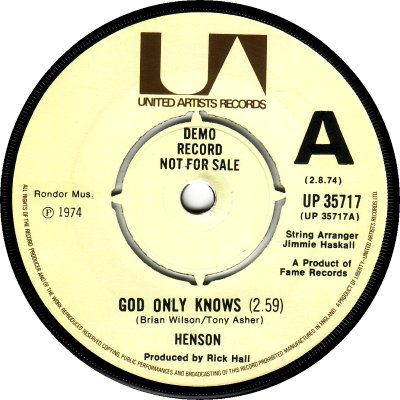
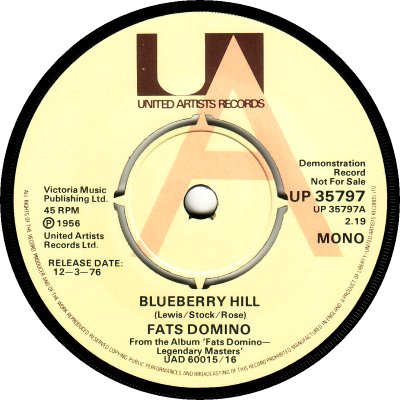

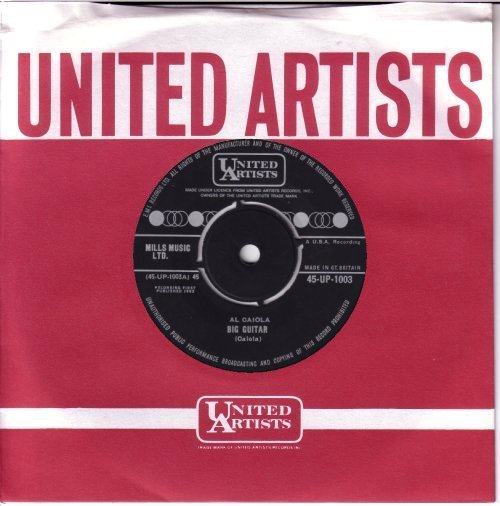
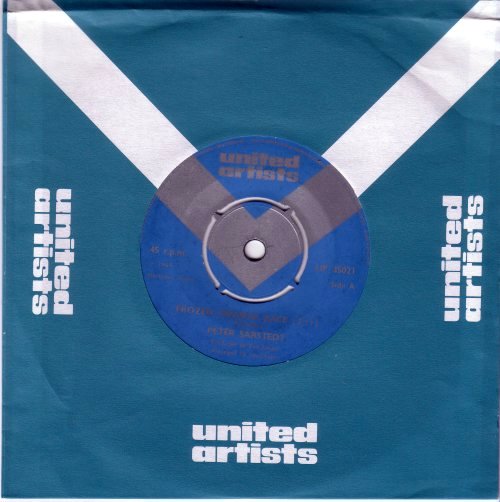
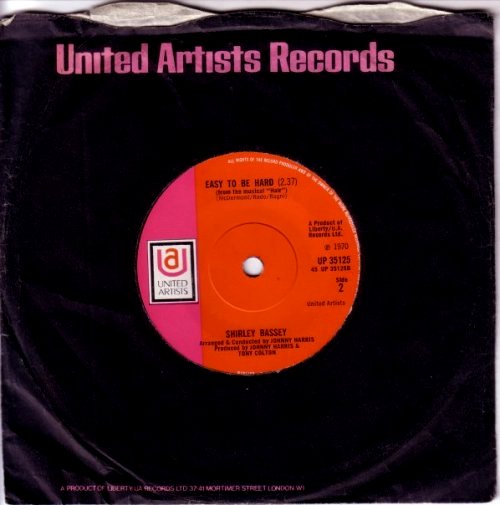
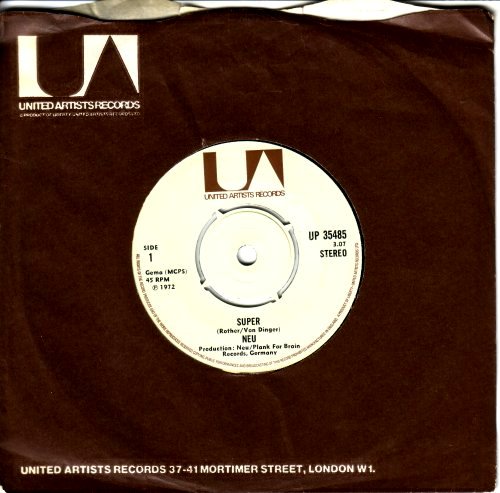
American, initially the record division of the United Artists film company. United Artists Records - which I'll refer to as UA Records from here onwards, for the sake of brevity - received its first mention in 'Billboard' in the issue of the 11th of November 1957, which said that Joe Valino had become the first artist to sign for the company. Its first single was scheduled to feature Valino singing 'Legend Of The Lost' from the film of the same name which starred John Wayne and Sophia Loren - United Artists went on to make something of a speciality of songs and soundtracks from films. The man in charge of the record and publishing wings of United Artists was Max Youngstein. 'BB' of the 2nd of December reported that distribution arrangements had been made with independents and that the first single was due out on the 9th of that month. There seems to have been a slight delay, as 'BB' of the 23rd of December claimed that the first two singles had been released 'last Friday'; it added that six or seven LPs were lined up, and that the aim was to get them under way by the end of January.
There were changes in personnel in 1958 as UA Records bedded down. Hal Schaeffer was retained as musical director in January ('BB' 6th January), and by March executive assistant Al Tamarin had been promoted to vice president under Youngstein ('BB', 24th March). He seems not to have stayed in the job for long, as 'BB' of the 3rd of November named Monte Kay as vice president and general manager. In addition to his position as musical director, Schaeffer was signed as an independent producer towards the end of the year, the agreement obliging him to proved six LPs for UA Records per year. On the music front, a United Artists advert in 'BB' of the 23rd of June stated that 'Try The Impossible' by Lee Andrews and the Hearts had given it its first hit; in passing it gave the company's address as 729 Seventh Avenue, New York City. The disc had been licensed from Casino Records of Philadelphia, and was one of the first fruits of United Artists' new policy of acquiring product from independent producers ('BB', 24th March). That policy didn't mean that film soundtracks were losing their importance: material from 'The Quiet American', 'The Vikings' and Bob Hope's 'Paris Holiday' were among that year's issues and were tied-in with the release of the films, 'The Vikings' being accompanied by two singles and an album ('BB', 23rd June). Again in 1958, UA Records sprouted a subsidiary, 'Unart', along with a publishing company of the same name. The label was to last for only a couple of years in its original form but it was relaunched in the mid '60s as a budget outlet.
Monte Kay's time as vice president and general manager came to an end after roughly six months. 'BB' of the 11th of May 1959 revealed that he had resigned 'last week' and had been replaced by David V. Picker. Another arrival was Don Costa, who was named A&R director and was made responsible for directing all recording activities for United Artists and its subsidiaries. He had occupied a similar position with ABC-Paramount for the previous four years ('BB', 3rd August 1959). The move paid off: 'BB' of the 23rd of November was able to state that the company was enjoying its 'biggest sales sprint' since its launch. Both film soundtrack recordings and independent productions continued to feature on UA Records' release schedule that year: a couple of tracks by Marv Johnson, 'Come To Me' and 'Whisper' were obtained from Berry Gordy's fledgling Tamla company ('BB',16th February) and proved very successful, while the release of 'Some Like It Hot' starring Marilyn Monroe had two albums and three singles tied-in to it - a similar arrangement had paid off for an earlier film, 'I Want To Live' ('BB', 9th March). In addition the company began to extend its overseas reach, signing long-term distribution deals with EMI for France, Belgium and Luxembourg ('BB', 15th June) - it had signed with Decca for the UK the previous year.
1960 saw UA Records with its third vice president / general manager in three years. 'BB' of the 13th of June reported that, after resigning as vice president of Mercury Records the previous week, Art Talmadge had been appointed to the posts and had been given the task of directing the over-all operations of both the recording and publishing wings of United Artists, presumably taking on responsibilities that had previously been Don Costa's. Talmadge's arrival sparked new activity: 'BB' of the 4th of July revealed that the company was considering a move into the R&B field, which was currently popular; and a few months later 'BB' of the 31st of October noted that it had taken its first steps in the Country market - Autry Inman had been signed, and more Country artists were being lined up. It added that a new audiophile series, 'Ultra Audio', was planned. According to the article these moves were part of a general expansion in the activities of UA Records, and the number of its executives had been increased accordingly. The first batch of Ultra Audio albums hit the shops in November ('BB', 7th November) and began to compete with those of other companies' labels which concentrated on the quality of the sound contained in the grooves. There was a slight hiccup when it was discovered that a firm called Oberline Inc. had the rights to the Ultra Audio name, but an amicable agreement was reached ('BB', 21st November). Aside from these activities, UA Records continued to do well in the Soundtrack area. 'BB' of the 23rd of May observed that the tie-up between films and records had had a positive effect on sales, so much so that United Artists had bought a television film company called ZIV; it was also bidding to release soundtracks of films made by other companies and intended to record cover versions of themes. 'BB' of the 26th of December commented that the influence between films and records worked both ways - by this time United Artists was working on building themes as singles hits in advance of the film's release and thus building up interest in the film when it eventually appeared.
In a move to establish UA Records' own identity overseas, Talmadge insisted that any new agreements would have to include the establishment of its own label. In Britain, Decca refused to meet that requirement, with the result that in April 1961 United Artists switched to EMI ('BB', 4th April). In 'BB' of the 17th of April a spokesman for Decca claimed that his company was 'unperturbed' at losing United Artists and had set its face firmly against sponsoring any new labels. He pointed out that Decca had spent a lot of money promoting United Artists artists and material, and stated that a 'split logo' deal had been offered which was similar to that which gave Atlantic's issues on the London label a certain amount of discrete identity. It was also similar to the deal which had been agreed with EMI, under which United Artists' records were to have credits to UA and to His Master's Voice. The new relationship with EMI led to some EMI artists signing to United Artists for America - Shirley Bassey was the first and arguably the foremost ('BB', 28th August 1961), Danny Williams and Charlie Drake were others. 'BB' of the 24th of July said that United Artists was 'Going all out' to build up its new Country & Western line: it was purchasing masters, and its intention was to feature the top names in the genre with the best independent producers handling the recording arrangements. The company's biggest single that year was a Folk one, 'Michael' by The Highwaymen. Lifted from an album that had been released the previous year, it topped the Singles Chart in September ('BB', 11th September). Finally for 1961, Talmadge was named president of UA Records after Max Youngstein retired. News of the appointment was broken in 'BB' of the 30th of October but was to be effective from the start of the new year.
UA Records continued to blossom in 1962. Drake had a novelty hit in the States with 'My Boomerang Won't Come Back' at the start of 1962, a success perhaps aided by United Artists sending out 3,000 cardboard boomerangs to promote it - the figure for promotional boomerangs of various sorts eventually reached 100,000, according to 'BB' of the 24th of February. A new subsidiary, Ascot, was launched in the spring ('BB', 24th March), and United Artists continued to broaden its interests. 'BB' of the 21st of April revealed that a new line of LPs of stories and music for children was in the offing, and the following week's edition added that, sparked by interest in Europe where the company was stepping up its activities, United Artists was reactivating its Jazz line - apparently it had placed heavy emphasis on Jazz in its first year. When autumn came around, 'BB' of the 8th of September was able to state that both the Children's and Jazz activities were expanding. The previous month 'BB' of the 18th of August had remarked on the fact that United Artists intended to diversify further, into the Classical market, before the end of the year. The article noted in passing that the company had made big gains in the field of Country, with 'She Thinks I Still Care' by George Jones proving particularly successful - it had clocked up 250,000 sales in six months. Towards the end of the year Jones's popularity was emphasized when he was named 'Favourite Male Artist' in the Country genre in Billboard's 15th DJ poll. Pianists Ferrante & Teicher, who had been with United Artists since late 1959, were doing even better in sales terms: in acknowledgement of the fact that they had sold 6,000,000 singles and 2,500,000 albums the company devoted April 1962 to promoting their records even more strongly ('BB', 5th May). Elsewhere 1962 was also notable for the fact that after it had shared credits with His Master's Voice for a year United Artists was given its own label identity in Britain.
1963 was comparatively quiet, though Ferrante & Teicher earned another gold record for sales of their 'Pianos In Paradise' LP. In contrast, 1964 was noteworthy. It began with Art Talmadge resigning after nearly four years in charge so that he could enter business for himself; he was replaced as president by David V. Picker, vice president of parent company the United Artists Corporation, and Si Mael became vice president and general manager ('BB', 15th February). A few months later 'BB' of the 23rd of May observed that Talmadge had bought the Musicor company and had signed 'a flock of artists'. By far the biggest happening of the year, however, was the release of the film 'A Hard Day's Night' and its accompanying soundtrack album, both, of course, featuring The Beatles. While Beatlemania had taken hold elsewhere it had yet to seize the USA; early Beatles records had been released by comparatively minor labels, and Capitol, which had first refusal on their output, had been slow to see the band's sales potential. Spotting an opportunity, United Artists put together the idea of a film featuring the band, and sold the concept to their manager, Brian Epstein. The songs written for the film would be available for inclusion on the soundtrack album and would therefore give UA Records prime new material to offer fans. The film proved hugely successful, as indeed did the soundtrack recording. Capitol responded by putting together its own new Beatles records ('BB', 4th July) but United Artists got theirs into the shops first and eventually came out on top in terms of sales. The sales proved to be phenomenal. 'BB' of the 11th of July reported that a million copies of the album had been sold and delivered within the space of four days, making it one of the fastest-selling records in the history of the music business; then a few months afterwards the issue of the 3rd of October added firstly that David Picker had presented The Beatles with a gold record, and secondly that sales were expected to hit the two million mark 'shortly'. As a reflection of those figures, the LP spent fourteen weeks occupying the top spot in the Billboard album Chart. Tangentially, UA Records signed Beatles producer George Martin as an artist - his instrumental recordings of Beatles songs had filled-out the AHDN album. There were some other goings-on: United Artists debuted the 'Fifty Fabulous' LP series, with fifty tunes spread over the two sides of an album ('BB', 22nd of February); the company launched an R&B label, 'Veep'; and an agreement was signed with UK company Ember giving UA first refusal on that company's recordings. Nothing compared to the excitement generated by 'A Hard Day's Night', however, and it is unsurprising that 1964 tended to be referred to as United Artists' 'Beatles Year'.
Inevitably, things calmed down in 1965. Providing further evidence to back the claim in 'BB' of the 18th of July of the previous year that United Artists had stepped out as a leader in film music activities over the past few years, the 'Goldfinger' soundtrack passed the $2 million sales mark in the summer ('BB', 10th July 1965) and later in the year 350,000 copies of the soundtrack to 'Thunderball' were shipped even before the film came out ('BB', 4th December). In a not unrelated area the company planned for a 'major drive' into Original Cast recordings ('BB', 23rd January), while elsewhere the children's LP line 'Tale Spinners' was said to be doing well, with 41 titles already in the catalogue and twelve to sixteen more each year in prospect ('BB', 6th March). Soundtracks continued to be big for United Artists in 1966: 'BB' of the 9th of April commented that the company was on a soundtrack 'splurge', with eight set to be issued before the end of the year and three more awaiting release dates. In other areas the R&B label Veep was revived following increased public interest in that kind of music (13th October), and Shirley Bassey left EMI and signed a long-term worldwide contract with UA Records ('BB', 23rd April). United Artists entered the 8-track cartridge market, initially with 62 items; more were planned to follow, with the emphasis - predictably - on soundtracks. Finally the company set up a British offshoot, United Artists Records Ltd, with a capital of $14,000; the first step on the road to independence ('BB', 19th November).
1967 began quietly with the announcement that UA Records intended to devote more time to Pop product while maintaining its soundtrack base ('BB', 21st January), but April brought a huge change: United Artists Pictures, Music and Publishing were purchased by insurance / finance / real estate company Transamerica. There was a slight lull while plans were developed; of interest to the UK was the news in 'BB' of the 10th of July that UA Records Ltd intended to follow the example set by MGM and Liberty, split with EMI and go it alone. The British company had two American directors - David Picker and Michael Stewart - and two British ones - Noel Rogers and Alan Spalding. It was to operate out of premises in Mortimer Street, London, and the prospective date for independence was October. In the event, however, the move was delayed.
The purchase by Transamerica sparked developments on several fronts. 'BB' of the 30th of September announced that the new owners had financed what United Artists officials described as 'One of the most massive expansion and acquisition programs the industry has seen'. Two new budget labels, True Action Adventure and the resuscitated Unart, had been launched the previous week; the Classical and Folk repertoires were to be extended via both artist signings and label acquisitions; and fourteen British acts including The Fortunes had been signed. United Artists was intended to 'own and operate virtually all its overseas operations worldwide', as part of which strategy it was to go into business for itself in Britain on the 1st of January the following year. The stated aim was for UA Records to become 'The complete record company'. 'BB' of the 14th of October was able to say that things were already moving with regard to Classical music, as United Artists returning to that field after releasing no new product for several years.
With regard to the UK scene, 'BB' of the 30th of October 1967 revealed that Mike Stewart, president of UK offshoot UA Records Ltd, was in discussions with current licensor EMI with regard to an early termination of the current deal, which still had a year to run. A pressing and distribution link with EMI was expected to continue. The negotiations bore satisfactory fruit, and 'BB' of the 11th of November was able to claim that United Artists would be going independent on the 1st of January, with Martin Davis as general manager and Noel Rogers managing director of United Artists' entire European operation. EMI would continue to handle distribution but United Artists would choose and promote its own releases and have its own sales staff. 'BB' of the 16th of December put the independence date back to February, in an article which observed that the launch was to be accompanied by a new logo and redesigned packaging and that similar autonomous operations were to be set up in other European capitols. There was another slight delay: 'Record Retailer' of the 21st of February 1968 said that the UK branch was to go fully independent at the beginning of March, with the first releases expected on the 15th of that month. The licensing deal with EMI had been due to expire in October but a new agreement had been reached, under which EMI would continue to handle manufacture and distribution of United Artists' product. Independence was to be celebrated with the introduction of a new logo, which had been designed by the Royal College of Art.
The main event of 1968 for United Artists in America came in April, when it gained a stablemate. 'BB' of the 6th of that month revealed that Transamerica had bought Liberty Records (q.v.), and a couple of months later 'BB' of the 22nd of June stated that a 'consolidation of functions' between the two record companies was taking place. UA Records was to become a wholly-owned subsidiary of Liberty Records, and Liberty was to become a wholly-owned subsidiary of United Artists Pictures. Both labels were to continue to operate autonomously. A week after that, 'BB' of the 29th supplied some management details: Al Bennett of Liberty had become president of UA Records, with Mike Lipton its general manager, while Mike Stewart was to become head of United Artists Music and Transamerica's other publishing interests. A short while later Noel Rogers was appointed managing director of Liberty's UK operation in addition to heading the British branch of United Artists; he was also given responsibility for directing the recording and publishing activities of both companies in Europe. Martin Davis, previously general manager of United Artists in Britain, took on the addition role of general manager of Liberty here ('BB', 13th July). Other items of news from 1968 were the launch of a Latino label by United Artists in the States ('BB', 13th January), a tour by British group Traffic ('BB', 23rd March), and a jump in the number of tape cartridges sold - according to 'BB' of the 23rd of November the number of units had more than doubled over the past six months and now accounted for 20% of the company's total sales. Finally 'BB' of the 30th of November quoted Mike Lipton as saying that 1969 was shaping up to be the company's best year, surpassing even the 'Beatle Year' of 1965.
After that flurry of activity 1969 proved relatively uneventful. 'RR' of the 5th of February was able to state that the integration of United Artists and Liberty was complete, and that the joined companies were to be known as 'Liberty-United Artists Records'. That aside, the only development of note was the signing of a deal with Fantasy Records (q.v.) which entitled Liberty-United Artists to issue its product in Britain, on the Liberty label. The move turned out to be an astute one, as Fantasy band Creedence Clearwater Revival provided Liberty and later United Artists with a string of hits into the early '70s. Another move was the establishment of the company's own sales force in Britain ('RR', 11th June 1969). 1970, likewise, was light on the 'news' front. 'BB' of the 18th of July observed that UA Records was seeking to extend its scope by representing more outside labels or groups for worldwide distribution; having started with Fantasy it had recently added Vault Records. The same issue noted that the company was pushing several UK acts, namely Groundhogs, The Humblebums, High Tide, Jody Grind, The Fortunes and 'High Wind' - actually Hawkwind. There was a development on the UK manufacture and distribution front: 'RR' of the 4th of April revealed that United Artists had looked into the cost of distributing its own records here, but decided against following that route and stayed with EMI. When Liberty severed its ties with Philips due to a 'financial disagreement' it moved to join its stablemate ('RR', 1st August).
1971 turned out to be more exciting, though not in a good way. It started calmly, with publishing company United Artists Music launching its own label. According to 'BB' of the 9th of January the new label was intended to be called New Morning but the name was awaiting copyright clearance. Clearance may not have been given, for when the label made its debut it was called Avalanche (q.v.). The arrival of one new label was soon followed by the departure of several old ones. 'BB' of the 23rd of January broke the news that the Liberty, Imperial, Minit and Sunset labels were being dropped, along with several lesser ones; UA Records was being given a new logo and pointed in a new creative direction, and the roster of 265 artists was to be reduced by 180. The head of the company in the UK was of the opinion that it was likely that there would be no change in Liberty's status as "the label means more here", but despite his optimism Liberty disappeared in Britain and the rest of Europe within five months. 'RR' of the 3rd of April added that following the lead of its American parent the British 'Liberty-United Artists' company was to be renamed just 'United Artists'; the United Artists label was to adopt the brown-and-cream design that was used in the States and was to become a 'single identity' label like CBS, covering all kinds of music - according to the article it had previously dealt with MOR and film soundtracks in the main. Despite the change of name mentioned in the article 'Liberty-United Artists Records Ltd' continued to appear on labels here for another five years or so. 'BB' of the 10th of April noted that as an economy move only selected artists were to have their records issued on tape automatically, with other releases being added if they were hits - despite the 1969 boom in the medium, overproduction had been a problem.
The reasons behind the economy measures soon became clear. 'BB' of the 15th of May 1971 reported that Transamerica's music division had made a loss in the first quarter of the year despite an increase in turnover. Then in its issue of the 14th of August 'BB' revealed that United Artists had made an $18 million loss in the previous year, prompting worldwide cost-cutting. Many disappointed Transamerica shareholders blamed the United Artists Corporation for adversely affecting their company's profits, and they wanted to 'get rid' of it. One analyst was quoted as saying that United Artists was 'especially stagnant' and that it required 'intensive and constant management disproportionate to its earnings potential'. A couple of months later 'BB' of the 20th of October was the bearer of more bad news: United Artists' record division had made a loss of $2.6 million in the first nine months of 1971. Despite that loss, the United Artists Corporation as a whole was 'on the credit side'. 'BB' of the 13th of November commented that United Artists had put a lot of capital investment into UK acts, and that despite having some successes with Creedence Clearwater Revival and Canned Heat, its catalogue was 'not particularly strong' and had a reliance on soundtracks. Finally 'BB' of the 27th of November shone some light onto the company's artist roster: it had been cut to twenty-five active acts over the past year, but five more had been added. Those five had all had records out previously, and it was reckoned that with the right promotion and marketing they could be successful. Among the five were were the Electric Light Orchestra, so the hunch proved accurate in that case. The Move and Roy Wood were included along with ELO, and Family and Brinsley Schawrz were two of the others.
In the Spring of 1972 'BB' of the 4th of March was able to provide a measure of comfort when it revealed that the losses made by United Artists' record division in 1971 had been less than those it made in 1970, but the article pointed out that they were still detracting from the profits made by the company's pictures division and its other operations. A small ray of light was cast by Don McLean's 'American Pie' which earned a gold record for sales over the first half of the year ('BB', 26th August). The performance of the record division continued to improve over the year, and 'BB' of the 3rd of March 1973 was able to say that it had made a 'small profit' for 1972 and had contributed to improved Transamerica end-year results. Cautiously optimistic, 'BB' of the 31st of March observed that United Artists was among the companies making inroads into the field of Country music, expanding its artists roster and upping its promotional efforts.
The turnaround in fortunes continued into 1974. 'BB' of the 13th of July highlighted the contribution made by the band War, which had grown to be the biggest act in the company's history and had generated sales of more than $33 million since 1971. There was still some reorganizing going on: 'BB' of the 15th of June noted that the company's last label-licensing deal had been altered to a production company arrangement, and the issue of the 24th of August said that United Artists' non-film operations had been restructured into a five-division 'music and records' group. A spokesman for the company was quoted as saying that the move was necessary for continued growth and expansion in its recording and music publishing activities. Aside from that, United Artists began to make use of its historic film soundtracks with the issue of 'The Golden Age of the Hollywood Musical', a compilation of material from Busby Berkley films, hitherto unavailable on record. It was a move that was to prove moderately successful, and it prompted the release of two similar albums in 1975, 'The Golden Age of Hollywood Stars' and a Laurel & Hardy compilation.
Further signs of recovery could be seen in 1975. United Artists had absorbed the venerable Jazz label Blue Note, which had been included in the acquisition of Liberty; most of its name artists had departed but new talent was to be steered in a 'more commercial' direction ('BB', 8th February). Blue Note's history wasn't being ignored: a programme of repackaging and reissuing was being undertaken. A similar move was being made with regard to United Artists' own back-catalogue ('BB', 22nd February). Efforts were being made to give Blue Note a new and more up-to-date image - it was now referring to Jazz as 'Street Music', was looking for 'creativity, uniqueness and commerciality' in the artists that it signed, and was promoting its records to Soul outlets. In Britain, Blue Note had been handled by Transatlantic for a while but United Artists' UK arm took over responsibility for it, the sales force emphasizing its crossover material, which had been 'successful in the USA'. Again in Britain, the mid-priced Sunset label was relaunched. In its previous existence, from 1969-73, Sunset had concentrated on MOR material, but in its new form it was to feature music from across the genres. Some old issues were being repromoted but six new titles were being released in the first batch as well ('BB', 16th August). One development which came to nothing was the release of United Artists' first quadraphonic LP, 'A Man For All Seasons' by John Gregory (BB', 15th February). Elsewhere War continued its run of successes, picking up a gold record for its single 'Why Can't We Be Friends' ('BB', 9th September).
The improvement continued in 1976. The summer found a new man installed as president of UA Records: Artie Mogull, previously with MCA among other companies. 'BB' of 9th of October celebrated United Artists' Nashville-based Country division, which boasted big-selling artists such as Kenny Rogers, Billie Jo Spears, Crystal Gayle and Slim Whitman among its stable. A licensing deal with Jet Records - mainly important because it brought ELO with it - was extended to cover the whole world instead of just America ('BB', 6th November). Then late on in the year the company's UK arm made a signing which would prove to be lucrative: it brought The Stranglers on board. What with one thing and another 'BB' of the 26th of February 1977 was able to award United Artists the title of 'Comeback Label And Corporation for 1976'.
Country music continued to be a big plus for UA Records in America in 1977, with independent producers Allen Reynolds and Larry Butler doing sterling work. Kenny Rogers and Crystal Gayle had 'crossover' hits, scoring in the main Charts not just the dedicated Country ones, and there were even successes in Britain - after a television campaign Slim Whitman's 'Red River Valley' album spent five weeks at No.1 here, one of the factors which enabled 'BB' of the 26th of March to report a 'surge in interest' on this side of the Atlantic. Back in the States, 'BB' of the 15th of October was able to comment that United Artists was continuing to 'improve its stability'; it had scored eight No.1s and was increasing its international activity. There was one notable departure from United Artists' British arm: late in the year Martin Davis left to form his own company, Radar (q.v.) ('Music Week', 19th November). Some things remained the same: 'BB' of the 29th of October revealed that piano duo Ferrante & Teicher had racked up their fourteenth gold album, and soundtracks continued to feature, the year's releases including those from 'Rocky' and 'The Spy Who Loved Me'.
1978 found United Artists sailing into choppier waters. Early on, Far Out Productions - War's management company - sued for $1 million, alleging failure to meet the terms of a contract signed in 1973. There was a big change in April when the M&R Music Corporation - recently formed by Jerry Rubinstein and UA Records president Artie Mogull - bought UA Records from Transamerica ('Music Week', 15th April). The cost of the purchase was put at $430 million by 'BB' of the 17th of February 1979 some months afterwards, in an article which said that funds had been provided by EMI - EMI had gained international distribution rights as a result of the deal. Transamerica retained the film and music publishing parts of United Artists and in addition put a time limit on the period during which M&R could use the United Artists name. A reorganization followed, and a campaign to exploit current product was undertaken ('BB', 1st July). The new owners were faced with problems. 'BB' of the 16th of September quoted Mogull as saying that when he and Rubinstein took over they had one hundred artists on the books and the same number of managers and agents to deal with; for 'self preservation' they had reduced the roster to twenty, enabling themselves to concentrate upon those artists. In Mogull's own words the label was changing from a 'department store' to a 'boutique'. There were other distractions, too: the second half of that year and the start of 1979 saw more lawsuits. Jet Records and other parties sued for 'up to $90 million' over the disposal of 580,000 copies of ELO's 'Out Of The Blue' album after Jet moved from United Artists to CBS ('BB', 12th August 1978). Mogull and Rubinstein counter sued ('BB', 6th January 1979), and a counter-claim was filed against Jet and the others by a firm called Promo Records which had bought more than a million ELO records and tapes from UA Records and was currently unable to sell them ('BB', 10th February).
'BB' of the 21st of January 1979 marked UA Records' twentieth and Transamerica's fiftieth anniversaries with a special supplement. The following month, however, UA Records was sold to Capitol / EMI for $3 million. In addition to making the payment the purchaser took responsibility for $32 million worth of liabilities. 'BB' of the 17th of February, which broke the news of the deal, said that the company had been struggling financially since the takeover by M&R Music. Rubinstein and Mogull were to stay on the board of 'Liberty United Records Inc.' - as mentioned above, as per the original agreement between M&R and Transamerica, United Artists Records was only entitled to use the name 'United Artists' for a limited period. The article continued that Jim Mazza, president of Capitol / EMI's 'EMI International' label, had been made general manager of UA Records, but that the plan was for United Artists and EMI International to continue autonomously. 'BB' of the 24th of March reported that Mazza had become president of both EMI and UA Records and that EMI International had moved to join United Artists at its Sunset Boulevard premises. There had also been mergers at the upper management and other levels - the article claimed that around fifty people had been made redundant, including the staff of UA Records' sales, merchandising and A&R departments. Eddie Levine, the head of Blue Note, was another departure, but the label itself would remain, perhaps to be administered by Capitol - at that point it was mainly a catalogue concern, its only active artist being Horace Silver. Thus it was that United Artists exited the decade under the ownership of Capitol-EMI.
United Artists as a label didn't last far into the 1980s. Liberty-United in the UK had a busy start to the decade when, following the closure of EMI's Licensed Repertoire Division, it was handed responsibility for eight labels licensed to EMI: Motown, Bronze, RAK, MAM, Hurricane, Source, Stax and Fantasy were the labels concerned ('MW', 26th January). Another upheaval followed: 'BB' of the 5th of July 1980 reported that Liberty-United in the UK was to be 'absorbed' by EMI. Nor was the American company immune to shiftings. 'BB' of the 6th of September broke the news that Liberty-United was to reassume its original name, Liberty Records, that month, and was also to readopt the old 'Statue of Liberty' logo. The article explained that the trading name United Artists Records had been widely used, leading to the misconception that the company was still connected to the United Artists Corporation and United Artists Publishing, both of which were still with Transamerica. The final United Artists singles duly came out in that month in the United States and in Britain, and subsequent releases were given a Liberty label with a new design. By the end of 1980 the United Artists label had disappeared from more or less every other country, an exception being Ireland, where it hung on till the end of 1981.
The United Artists releases in the UK were predominantly American in origin until the establishment of the British arm of the company in the mid '60s, and they concentrated upon MOR material and songs and music from films until that point; a few British artists featured on the label, but they were signed to the American company. When the UK branch got into its stride, in 1968, British productions began to appear alongside American ones, and the range of music featured started to broaden. In the '70s the catalogue grew cover a wide spectrum of genres, from MOR through Country, Pop, Folk, Rock, Punk, Soul and Disco. A licensing agreement with the Ballistic label (q.v.) added Reggae to the list, and even 'Krautrock' was catered for, with the likes of Can, Neu and Amon Duul.
UA Records was able to boast a decent number of Singles Chart successes, but it was not until the '70s that it began to appear in the Chart with any degree of frequency. Marv Johnson's 'You Got What It Takes' b/w 'Don't Leave Me' (HLT-9103; 12/59) provided the company with its first big hit, during the London years, reaching the No.5 spot, and 'Michael' b/w 'Santiano' by The Highwaymen (POP-910; 9/61) supplied its first No.1, on the twin-logo His Master's Voice / United Artists label. In addition Gene Pitney managed a couple of Top Ten entries in 1963-64, but a consistent hit-maker was lacking - Pitney racked up a string of successes, but most of them came after his label, Musicor, moved from United Artists to Stateside. Shirley Bassey was arguably the most consistent visitor to the Charts, for a time at least, managing three Top Ten singles and three lesser placings between 1967 and 1973, but the hits were accompanied by a number of misses, and more misses followed, reaching into 1979. Bobby Goldsboro took 'Honey' b/w 'Danny' to the No.2 position twice, in 1968 (UP-2115; 4/68) and in 1975 (UP-35705; 2/75), separated by a couple of lesser hits, but these were currants in his bun of around twenty-five singles from 1964 to 1976; and while Peter Sarstedt's second single, 'Where Do You Go To' b/w 'Morning Mountain' (UP-2262; 1/69) gave United Artists its second No.1 the follow-up peaked at No.10 and five subsequent singles failed to register at all. Don McLean did marginally better: after his second single, 'American Pie (Parts 1 & 2) (UP-35325; 1/72) stalled at No.2, 'Vincent' b/w 'Castles In The Air' (UP-35359; 3/72) reached the coveted top spot. However, his next attempt got nowhere, and after just tickling the Top 40 with 'Every Day' b/w 'The More You Pay' (UP-35519; 3/73) he had three more misses before moving to EMI.
Even artists who charted highly and frequently in America weren't guaranteed frequent Chart entries in Britain. Ferrante & Teicher, whose records sold in huge numbers in the USA, were restricted to a couple of early hits over here, and even the big Country stars from the 1970s stuttered. Billie Jo Spears managed Top Ten placings with her first and third singles, 'Blanket On The Ground' b/w 'Come On Home' (UP-36805; 4/75) and 'What I've Got In Mind' b/w 'Evertytime Two Fools Collide' (UP-35661; 5/76), but only two of her next eleven attempts managed to chart and neither of them made it into the Top Thirty. Crystal Gayle suffered four misses before reaching No.5 with 'Don't It Make My Brown Eyes Blue' b/w 'All I Wanna Do In Life' (UP-36307/ 10/77); after another miss she got to No.11 with 'Talking In Your Sleep' b/w 'Paintin' This Old Town Blue' (UP-36422; 8/78), but after four more misses she moved to CBS. Again, Kenny Rogers managed two No.1s with 'Lucille' b/w 'Till I Get It Right' (UP-36242; 4/77) and 'Coward Of The County' b/w 'I Want To Make You Smile' (UP-614; 1/80), but they came in among a mixed bag of misses and minor placings. Both American and British artists enjoyed one or more good Chart hit only to fall away: Inez & Charlie Foxx, Ike & Tina Turner, Hawkwind, Paul Anka, Gerry Rafferty (twice) and The Vapors all got into the Top Six, as indeed did Laurel & Hardy, whose failure to follow up their novelty No.2 'Trail Of The Lonesome Pine' b/w 'Honolulu Baby' (UP-36026; 10/75) with other hits was perhaps more predictable. Other artists had the opposite problem, registering a decent number of minor placings without climbing to the heights - Buzzcocks scored eight times from twelve attempts but only got into the Top Twenty twice, and of Dr. Feelgood's six Chart entries only 'Milk & Alcohol' b/w Every Kind Of Vice' (UP-36468; 1/79) made it into the Top Thirty, rising as high as No.9. The label's most frequent visitors to the Chart were The Stranglers, with twelve hits from 1977 into 1980, five of them making it into the Top Twenty. They added five more after the change of label name to Liberty.
United Artists used several different label designs during the course of its lifetime. During the Decca era its records came out on the London label with a dedicated HLT prefix and a credit to United Artists Records (1). Early EMI issues shared label credits and POP-000 catalogue numbers with HMV records. The label colours seem to have been the same as those of HMV singles; they were blue for the most part (2) with an occasional black one (3) as the result of a late re-pressing. Some singles which had sold well on London were reissued with new catalogue numbers (1, as 2) during this period. In August 1962 United Artists got its own black-and-silver label (4) and a dedicated 45UP-1000 numerical series; the '45' part of the prefix disappeared after 45UP-1015, in February 1963. The design remained basically the same for several years, the main change being the addition of the 'Sold in the U.K.' text under the spindle hole (5), which took place in January 1964. When United Artists went independent, in March 1968, the catalogue numbers jumped to UP-2209 and a silver-on-light-blue label was adopted (6). The UP-2200 series continued until April 1969, when a UP-35000 series came in.
The light-blue-and-silver label was superseded by an orange-and-pink one (7) in August 1969, with UP-35027. The plain orange variant (8), which Robert Bowes has kindly supplied, would appear to be a one-off, presumably caused by a shortage of the standard labels. In April 1971 a brown-on-fawn label appeared (9); UP-35204 seems to have been the first single to bear it. This design remained essentially unchanged for the rest of the decade, though the base colour hovered between fawn and pale creamy yellow; the only alteration was that the part of the perimeter legend which read 'A product of Liberty-United Artists Records Ltd' lost the reference to 'Liberty' after August 1976 (15). The were exceptions and variants: for Rhythm 'n' Blues singles, such as those by Dr. Feelgood and the Flaming Groovies, the colours were changed to silver-on-black (10), while the black-on-yellow colour (12) seems to have been a one-off and may again have been a result of shortages of the fawn labels. The 'American Townscape' design (11) from 1973 seems to have been limited to a couple of licensed singles by Country Gazette (UP 35659) and The Dillards (UP-35660). Occasionally, presumably because of contract pressings being done for EMI by Phonodisc, popular UA singles could be found with injection moulded labels (13, 14). Some artists, such as The Stranglers (17), Buzzcocks (18) and 999 (19), were given their own individual label designs.
With regard to promo copies, while United Artists was licensed to EMI its promos followed the standard EMI pattern: they started out as white with a large red 'A' (20, 21) and changed to a white 'A' on green in October 1966 (22). After independence various forms of overprinting were used. Promo copies of fawn-labelled singles from 1971 until late 75 generally had an RCA-style look (25, 26, 27), but manufacturing continued to be by EMI. In the spring of 1974 some promos adopted the generic EMI form, with the small black 'A' and the 'DEMO RECORD NOT FOR SALE' wording (28); they were interspersed with the other kind, which remained by far the more common of the two. In October 1975 United Artists introduced a different and distinctive promo style, with a large but faint red 'A' (29); again the wording - 'Demonstration Record Not For Sale' - was more typical of RCA. There were a number of promotional or bonus singles; these came in a variety of catalogue series, the most frequently used of which were FREE-0 and UPS-0.
Catalogue numbers appear to have jumped from 35899 to 36000 in 1975, except for a couple of entries at 35951 and 35952. In the summer of 1979 this UP-36000 series was replaced by two separate ones, UP-600 and BP-300; according to 'MW' of the 16th of June the UPs were for original product sourced from Liberty-United records in America, while the BPs were for material which was either of British origin or was licensed by the British company. A series of EPs of past hits appeared from 1973-1976, with numbers in the REM-400s, for 'Remember'. Some of these EPs had a special label design, featuring a stylised American car (16). This label, which later had the words 'The 'Silver Spotlight Series' included on it, was used for some reissues into the 1980s, with standard UP-36000 catalogue numbers. There was a special sleeve for these later reissues, and they were distinctive enough to merit their own page on this site - see 'Silver Spotlight'.
Some early fawn-labelled singles came in the black company sleeve (33), presumably as a result of old stock being used up. The brown sleeve (34) appears to have been restricted to two or three years in the first half of the '70s; singles from the second half had plain white sleeves or picture ones. Labels associated with United Artists in the '70s included Avalanche, Cow Pie, Grateful Dead, Golden Melodies, Jet, Midnight Hour, Pepper, Punilux and Rockfield (q.v. all). The discography below only covers the 1970s.



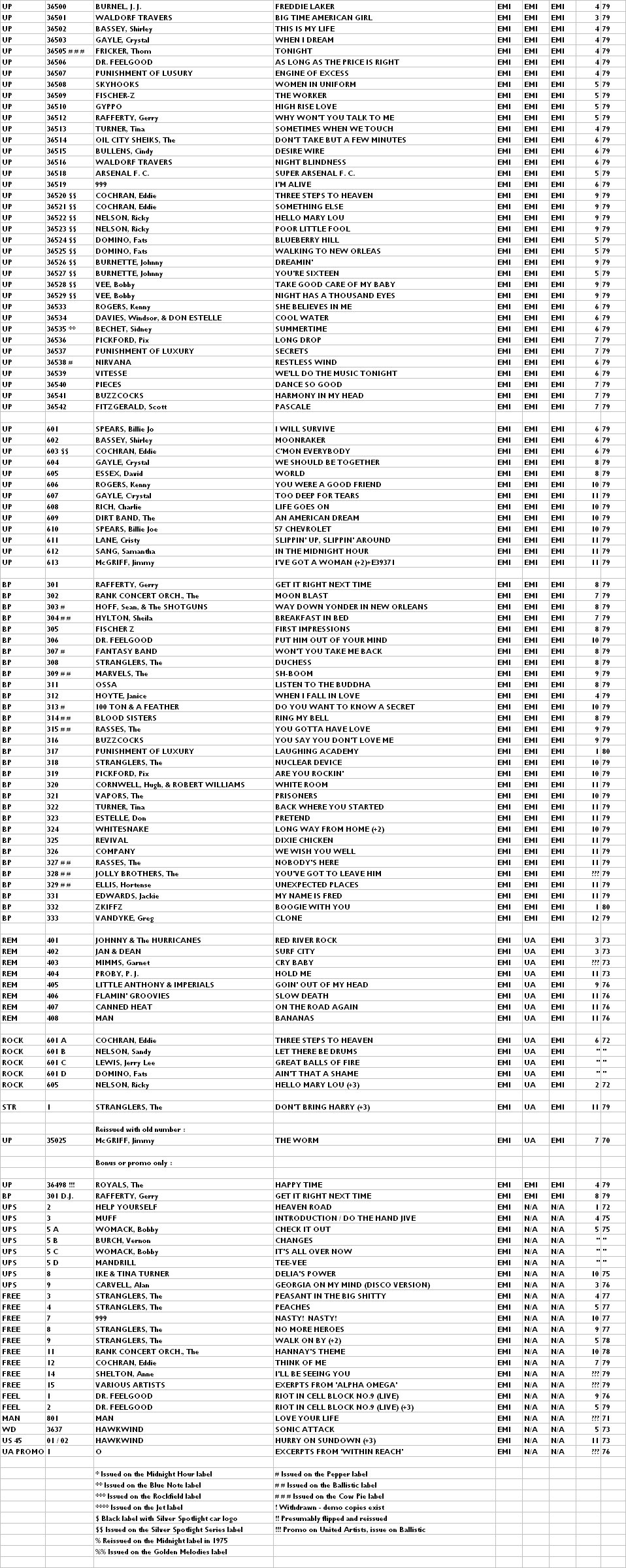


Copyright 2006 Robert Lyons.

